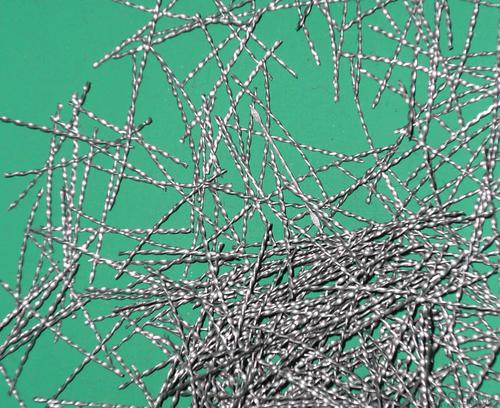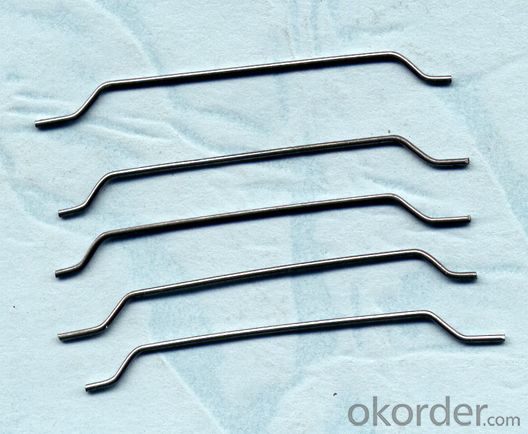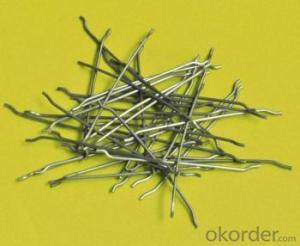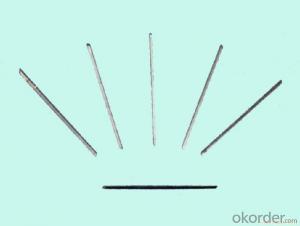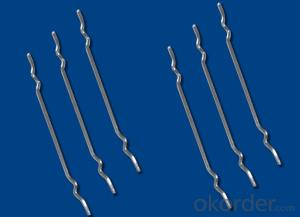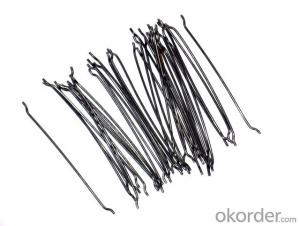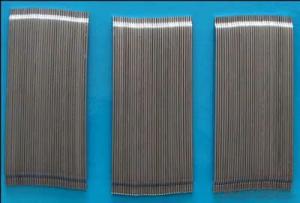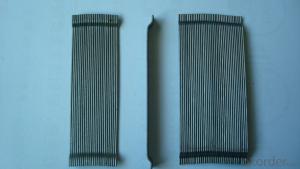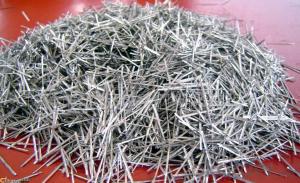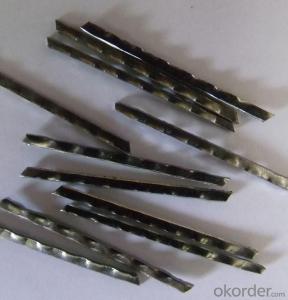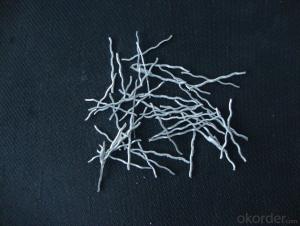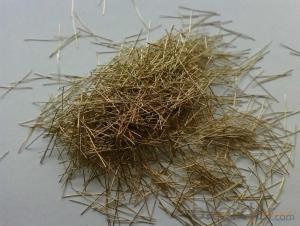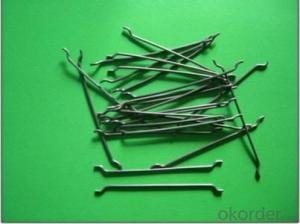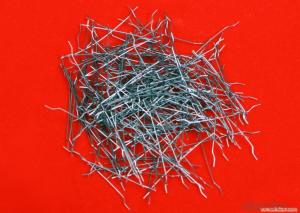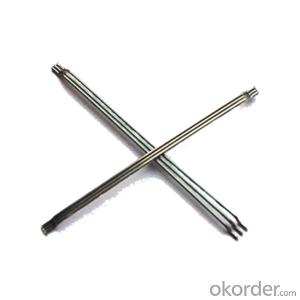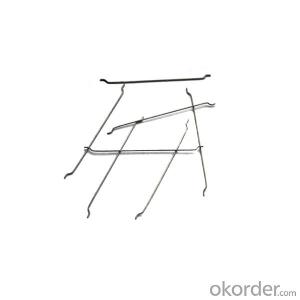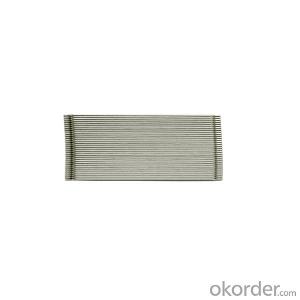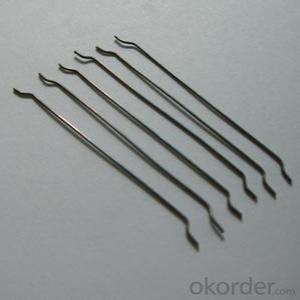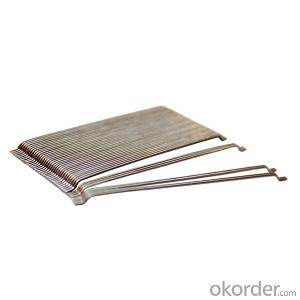Melt Extract Stainless Steel Fiber - Steel Fiber Copper Coated by CNBM International
- Loading Port:
- Tianjin
- Payment Terms:
- TT OR LC
- Min Order Qty:
- 1000 kg
- Supply Capability:
- 30000 kg/month
OKorder Service Pledge
OKorder Financial Service
You Might Also Like
Quick Details
Place of Origin: Jiangsu, China (Mainland)
Model Number: HT-ST
Material: Steel
Specifications
The raw material is stainless steel ingots, using electric stoves which melt the stainless steel ingots to become 1500 ~ 1600 ℃ steel liquid, and then with a grooved high speed rotating melt-extracting steel wheel which produces wires that meets are our customers’ specific requirements. When melting down to a wheel steel liquid surface, the liquid steel blow out by slot with centrifugal force at extremely high speed with cooling forming. Melting wheels with water keep the cooling speed. This method is done to produce different material, different sizes of steel fiber.
| SIZE | CHEMIC ELEMENT(%) | ||||||
| C | P | Mn | Si | Cr | Ni | Al | |
| AISI330 | ≤0.40 | ≤0.04 | ≤2.00 | ≤0.75 | 17~20 | 33~37 | |
| AISI310 | ≤0.40 | ≤0.04 | ≤2.00 | ≤1.50 | 24~26 | 19~22 | |
| AISI316 | ≤0.40 | ≤0.04 | ≤2.00 | ≤1.00 | 16~18 | 10~14 | |
| AISI314 | ≤0.40 | ≤0.045 | ≤2.00 | 1.5-3.0 | 23~26 | 19~22 | |
| AISI309 | ≤0.40 | ≤0.04 | ≤2.00 | ≤1.00 | 22~24 | 12~15 | |
| AISI304 | ≤0.40 | ≤0.04 | ≤2.00 | ≤2.00 | 18~20 | 8~10 | |
| AISI301 | ≤0.40 | ≤0.04 | ≤2.00 | ≤2.00 | 16~18 | 6~8 | |
| AISI201 | ≤0.40 | ≤0.06 | 5.5~7.5 | ≤1.00 | 16~18 | 3.5~5.5 | |
| AISI446 | ≤0.40 | ≤0.04 | ≤1.50 | ≤2.00 | 23~27 | ||
| AISI430 | ≤0.40 | ≤0.03 | ≤1.00 | ≤2.00 | 16~18 | ||
| NAS430A | ≤0.40 | ≤0.03 | ≤0.50 | ≤0.50 | 16~18 | 2~4 | |
| SIZE(mm) | ||||
| length | 20 | 25 | 30 | 35 |
| width | 0.75~1.5 | 0.75~1.5 | 0.75~1.5 | 0.75~1.5 |
| thickness | 0.2~0.75 | 0.2~0.75 | 0.2~0.75 | 0.2~0.75 |
Picture
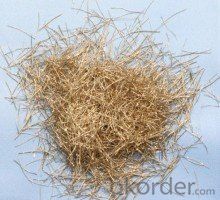
Steel fiber
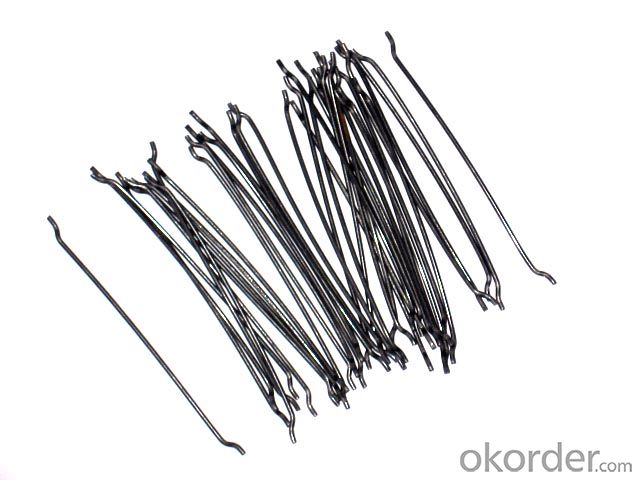
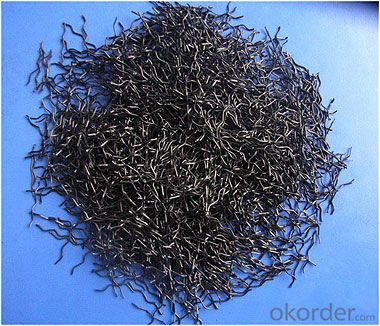
FAQ
certificated: ISO 9001
Technical advantages of Daye steel fiber:
A. Improve mechanical performance of concrete
B. Provide uniform distribution throughout concrete with excellent mixing
C. No balling or caking by adopt correct mixing method
D. Reduce concrete volume
E.Save construction time and cost
F.Reduce excavation volume
G.Available for jointless floor.
- Q: Can melt extract stainless steel fiber enhance the resistance of concrete to chemical attack?
- Yes, melt extract stainless steel fiber can enhance the resistance of concrete to chemical attack. The addition of stainless steel fibers improves the durability and performance of concrete by reducing the impact of chemical substances that could potentially degrade the concrete. Stainless steel fibers provide additional strength, increase the concrete's resistance to cracking, and enhance its overall lifespan in harsh chemical environments.
- Q: Does melt extract stainless steel fiber improve the ductility of concrete?
- Concrete can have improved ductility by incorporating melt extract stainless steel fiber. The addition of stainless steel fibers enhances the flexural strength and toughness of concrete. These fibers function as reinforcement within the concrete matrix, forming a network that aids in stress distribution and inhibiting crack propagation. This reinforcement enhances concrete's capacity to deform and absorb energy prior to failure, ultimately enhancing its ductility. Furthermore, stainless steel fibers possess high tensile strength and corrosion resistance, thereby further augmenting concrete's improved ductility.
- Q: Is melt extract stainless steel fiber compatible with various types of cement?
- Various types of cement are compatible with melt extract stainless steel fiber. These fibers are specially designed to boost the effectiveness of cement-based materials, such as concrete. They offer reinforcement, enhance durability, improve crack resistance, and strengthen the overall cement matrix. Melt extract stainless steel fibers possess exceptional chemical resistance, enabling them to maintain their integrity and effectiveness even when exposed to different types of cement and aggressive substances. Consequently, whether it's Portland cement, fly ash cement, or any other variety, melt extract stainless steel fibers can effectively enhance their properties and performance.
- Q: What is the typical dosage of melt extract stainless steel fiber in concrete?
- The typical dosage of melt extract stainless steel fiber in concrete varies depending on the specific application and desired performance. However, a common dosage range is typically between 20 to 40 kilograms per cubic meter of concrete.
- Q: Can melt extract stainless steel fiber be used in cooling tower construction?
- Yes, melt extract stainless steel fiber can be used in cooling tower construction.
- Q: How does melt extract stainless steel fiber contribute to the fatigue behavior of concrete?
- Melt extract stainless steel fiber plays a significant role in enhancing the fatigue behavior of concrete. The addition of these fibers in the concrete mix improves its resistance to cracking and increases its durability, particularly under cyclic loading conditions. One of the main ways in which melt extract stainless steel fiber contributes to the fatigue behavior of concrete is by reducing the propagation of microcracks. As concrete is subjected to repeated loading and unloading cycles, microcracks begin to form and propagate, leading to eventual failure. However, the presence of stainless steel fibers acts as a reinforcement, effectively bridging these microcracks and preventing their further propagation. This improves the overall fatigue resistance of the concrete and extends its service life. Moreover, melt extract stainless steel fibers also enhance the tensile strength and ductility of concrete. Concrete is known for its low tensile strength, and the inclusion of fibers helps to overcome this weakness. The fibers distribute the applied load more evenly throughout the concrete matrix, reducing stress concentrations and enhancing its ability to withstand cyclic loading. This, in turn, leads to improved fatigue behavior. Additionally, the use of melt extract stainless steel fibers in concrete can also improve its resistance to corrosion. Stainless steel is inherently resistant to corrosion, and when incorporated into the concrete mix, it acts as a protective barrier against the ingress of aggressive substances such as chlorides and sulfates. This helps to prevent corrosion of the reinforcing steel within the concrete, which can weaken its structural integrity and lead to premature failure. In conclusion, melt extract stainless steel fiber greatly contributes to the fatigue behavior of concrete by reducing microcrack propagation, increasing tensile strength and ductility, and improving resistance to corrosion. These benefits enhance the overall durability and lifespan of concrete structures, making them more reliable and cost-effective in the long run.
- Q: Bridge deck pavement 8cm steel fiber micro expansion concrete, which kind of mixer can meet the requirement later?
- Stir (about 2-4 minutes) and then into the cement and water mixing (wet cement can be put in dry mixing), can be adjusted according to the amount of transportation and transportation distance of the steel fiber concrete slump, if it is pumping, the slump can be slightly larger!
- Q: Is melt extract stainless steel fiber suitable for use in self-compacting concrete?
- Yes, melt extract stainless steel fiber is suitable for use in self-compacting concrete. This type of fiber is known for its excellent corrosion resistance and high tensile strength, making it ideal for reinforcing self-compacting concrete. The fibers can effectively improve the mechanical properties of the concrete, including its flexural and tensile strength, as well as its resistance to cracking and impact. Additionally, melt extract stainless steel fibers have a high aspect ratio, which helps to enhance the cohesion and homogeneity of the concrete mixture. Overall, using melt extract stainless steel fiber in self-compacting concrete can result in a more durable and robust material, making it suitable for various construction applications.
- Q: What is the recommended spacing between melt extract stainless steel fibers in concrete?
- The recommended spacing between melt extract stainless steel fibers in concrete typically ranges from 1 inch to 2 inches.
- Q: Can melt extract stainless steel fiber be used in fiber-reinforced polymers (FRP)?
- Melt extract stainless steel fiber is applicable in fiber-reinforced polymers (FRP). FRP composites commonly employ stainless steel fibers to enhance mechanical properties like strength, stiffness, and toughness. During manufacturing, these fibers are typically added to the polymer matrix to improve the overall performance of the composite material. The excellent corrosion resistance, high tensile strength, and good thermal stability of melt extract stainless steel fibers make them suitable for applications where durability and reliability are crucial in FRP. Moreover, the presence of stainless steel fibers can also provide electromagnetic shielding properties to FRP composites, making them suitable for specific uses in industries such as aerospace or automotive. In summary, melt extract stainless steel fibers are effective in enhancing the mechanical and functional properties of fiber-reinforced polymers.
Send your message to us
Melt Extract Stainless Steel Fiber - Steel Fiber Copper Coated by CNBM International
- Loading Port:
- Tianjin
- Payment Terms:
- TT OR LC
- Min Order Qty:
- 1000 kg
- Supply Capability:
- 30000 kg/month
OKorder Service Pledge
OKorder Financial Service
Similar products
Hot products
Hot Searches
Related keywords



